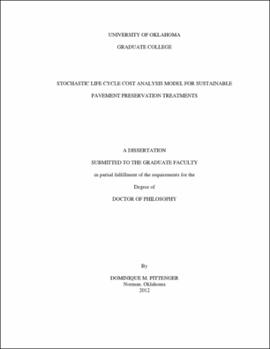| dc.contributor.advisor | Gransberg, Douglas D||Zaman, Musharraf | |
| dc.creator | Pittenger, Dominique | |
| dc.date.accessioned | 2019-04-27T21:21:40Z | |
| dc.date.available | 2019-04-27T21:21:40Z | |
| dc.date.issued | 2012 | |
| dc.identifier | 99122935702042 | |
| dc.identifier.uri | https://hdl.handle.net/11244/318488 | |
| dc.description.abstract | Classic engineering economic theory was developed to furnish the analyst a tool to | |
| dc.description.abstract | compare alternatives on a basis of life cycle cost. However, the theory is applied to new | |
| dc.description.abstract | construction projects with relatively long service lives and as such does not accurately model the | |
| dc.description.abstract | economic aspects of short-lived alternatives such as those that pavement managers must evaluate | |
| dc.description.abstract | when seeking to select the most cost effective pavement preservation treatment. The field of | |
| dc.description.abstract | pavement preservation seeks to "keep good roads good" and hence pavement preservation | |
| dc.description.abstract | treatments are applied to extend the functional service life of the underlying pavement. As a | |
| dc.description.abstract | result, no significant research has been done to quantify the actual service lives of the pavement | |
| dc.description.abstract | preservation treatments themselves and furnish a model for the life cycle cost analysis (LCCA) of the treatments themselves. This dissertation fills those two gaps in the pavement economics body of knowledge by proposing a new pavement preservation life cycle cost model and a methodology for using field test data to quantify the service lives of pavement preservation treatments for both asphalt and concrete pavements. | |
| dc.description.abstract | The model created for this research is based upon the fundamental but little used engineering economic theory of equivalent uniform annual cost (EUAC) applied for the first time to pavement LCCA and engineering technical data for highway pavement preservation projects. The EUAC-based life cycle cost analysis model eliminates some theoretical issues associated with the current Federal Highway Administration method (net present value) and specifically addresses the short-term nature of pavement preservation treatments. | |
| dc.description.abstract | The research proposes a methodology for the use of microtexture and macrotexture deterioration models that provide local pavement condition data that correlate with service life and pavement life extension model input values. | |
| dc.description.abstract | The research concludes that a LCCA model based on EUAC, rather than net present value, is more appropriate for pavement preservation treatments. EUAC allows the engineer to better relate treatment life cycle cost output to annual maintenance budgets and specifically determine the most cost effective treatment for a given project. This can furnish pavement managers measurable failure criteria to estimate extended service lives of the nation's pavements. | |
| dc.format.extent | 238 pages | |
| dc.format.medium | application.pdf | |
| dc.language | en_US | |
| dc.relation.requires | Adobe Acrobat Reader | |
| dc.subject | Pavements--Maintenance and repair | |
| dc.subject | Roads--Maintenance and repair | |
| dc.subject | Pavements--Overlays | |
| dc.title | Stochastic Life Cycle Cost Analysis for Sustainable Pavement Preservation Treatments | |
| dc.type | text | |
| dc.type | document | |
| dc.thesis.degree | Ph.D. | |
| ou.group | College of Engineering::Department of Engineering | |
